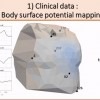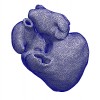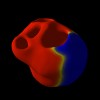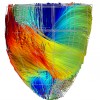3D Strain Assessment in Ultrasound (STRAUS)
Inria coordinator: Maxime Sermesant
Objectives
The STRAUS project aims at introducing a reliable unified pipeline for the in silico evaluation and comparison of 3D speckle tracking solutions. This effort started with the organization of the Motion Tracking Challenge at MICCAI 2012, where a new pipeline for the simulation of 3D ultrasound recording was developed and used to contrast five motion tracking solutions from 5 leading groups in the field. The simulation pipeline combined state of the art solutions in the fields of electromechanical modeling and ultrasound simulations to obtain realistic motion patterns and speckle properties. Results of that comparison study are reported in [5] and more extensively in [6].
Building from that initial effort we have recently developed a novel simulation protocol with an original solution to learn speckle texture from a real ultrasound recording. Unlike existing solutions, the so obtained simulated images fairly included all major elements that make motion tracking in ultrasound still challenging as:
- Motion of surrounding structures as papillary muscles and valves;
- Heterogeneities of speckle contrast inside the myocardium;
- Speckle decorrelation over time.
For a description of the simulation framework see [3] and [7].
The new pipeline was used to generate an initial library of 8 sequences including healthy and pathological cases. For each sequence B-mode voxel data, RF signals and ground truth meshes are made freely available for download (see below).
A web-based interface to visualize and navigate through the synthetic datasets can be found at: https://desk.creatis.insa-lyon.fr/straus/
Please note that the use of such data is citation-ware. Hereto [3] should be properly referenced.
Open Access Dataset
For each dataset the following are available:
- B-mode simulated voxel data (.mhd)
- RF signals (.mat)
- The set of ground truth meshes (.vtk)
- together with some MATLAB functions to read and align B-mode, RF and ground truth meshes. All data and routines can be downloaded here: http://www-sop.inria.fr/asclepios/data/STRAUS/.
Results from a first comparison study
We have used the synthetic datasets to run a comparison study between 5 state-of-the art speckle tracking algorithms from academia and industry. The techniques considered are heterogeneous in terms of methodology (i.e. elastic registration vs. block matching vs. optical flow) and data used (i.e. b-mode voxel data vs. raw radiofrequency signals). The results of the comparison are reported in [8].
The data used is the one of the open access dataset, presented above. For reproducibility, we make the following available for download at this link:
- The results obtained by each participant;
- The MATLAB scripts used to compute the error metrics and reproduce the figures contained in the paper [8];
The provided scripts should be used to benchmark new techniques and compare directly with what reported in [8].
References
- M. Alessandrini, B. Chakraborty, B. Heyde, O. Bernard, M. De Craene, M. Sermesant, J. D’hooge. Realistic Vendor-Specific Synthetic Ultrasound Data for Quality Assurance of 2D Speckle Tracking Echocardiography: Simulation Pipeline and Open Access Database. IEEE Transactions on Ultrasonics, Ferroelectrics, and Frequency Control, 2018.
- Y. Zhou, S. Giffard-Roisin, M. Craene, J. Hooge, M. Alessandrini, D. Friboulet, M. Sermesant, O. Bernard. Framework for the generation of realistic synthetic cardiac US and MRI sequences from the same virtual patients. IEEE Transactions on Medical Imaging, 2018.
- M. Alessandrini, M. De Craene, O. Bernard, S. Giffard-Roisin, P. Allain, I. Waechter-Stehle, J. Weese, E. Saloux, H. Delingette, M. Sermesant, J. D’hooge. A pipeline for the generation of realistic 3D synthetic echocardiographic sequences: methodology and open-access database. IEEE Transactions on Medical Imaging, 34(7) 2015.
- A. Porras, M. Alessandrini, M. De Craene, N. Duchateau, M. Sitges, B. Bijnens, H. Delingette, M. Sermesant, J. D’Hooge, A. Frangi, and G. Piella. Improved Myocardial Motion Estimation Combining Tissue Doppler and B- Mode Echocardiographic Images. IEEE Transactions on Medical Imaging, 33(11), 2014.
- M. De Craene, S. Marchesseau, B. Heyde, H. Gao, M. Alessandrini, O. Bernard, G. Piella, A. Porras, E. Saloux, L. Tautz, A. Hennemuth, A. Prakosa, H. Liebgott, O. Somphone, P. Allain, S. Ebeid, H. Delingette, M. Sermesant, J. D’hooge, E. Saloux. 3D strain assessment in ultrasound (STRAUS): A synthetic comparison of five tracking methodologies. IEEE Transactions on Medical Imaging, 32(9), 2013.
- M. De Craene, P. Allain, H. Gao, A. Prakosa, S. Marchesseau, L. Hilpert, O. Somphone, H. Delingette, S. Makram-Ebeid, N. Villain, J. D’hooge, M. Sermesant, and E. Saloux, “Computational and Physical Phantom Setups for the Second Cardiac Motion Analysis Challenge (cMAC2),” in STACOM. New York: Springer, 2012, vol. 7746, LNCS, pp. 125–133.
- De Craene, M.; Alessandrini, M.; Allain, P.; Marchesseau, S.; Waechter-Stehle, I.; Weese, J.; Saloux, E.; Morales, H.G.; Cuingnet, R.; Delingette, H.; Sermesant, M.; Bernard, O.; D’hooge, J., “Generation of ultra-realistic synthetic echocardiographic sequences,” Biomedical Imaging (ISBI), 2014 IEEE 11th International Symposium on , vol., no., pp.73,76, April 29-May 2 2014.
- M. Alessandrini, B. Heyde, S. Queirós, S. Cygan, M. Zontak, O. Somphone, O. Bernard, M. Sermesant, H. Delingette, D. Barbosa, M. De Craene, M. O’Donnell and J. D’hooge, Detailed Evaluation of Five 3D Speckle Tracking Algorithms using Synthetic Echocardiographic Recordings, IEEE Transactions on Medical Imaging, 2016.




 Non invasive cardiac personalisation
Non invasive cardiac personalisation
 Simulation of ventricular tachycardia re-entry circuit
Simulation of ventricular tachycardia re-entry circuit
 heartMeshFine
heartMeshFine
 Electrophysiology
Electrophysiology
 Cardiac Fibres from in vivo Diffusion Tensor Imaging
Cardiac Fibres from in vivo Diffusion Tensor Imaging
